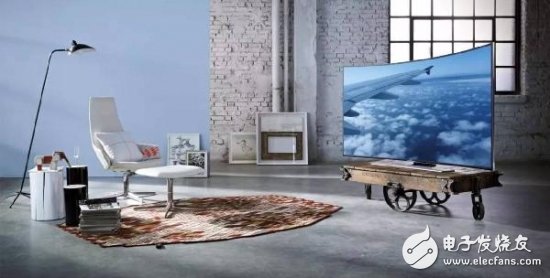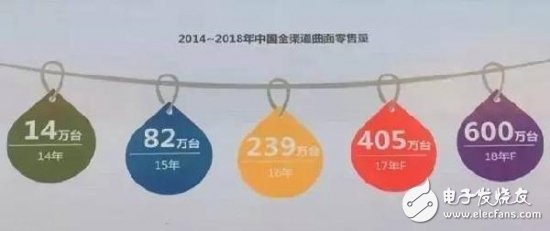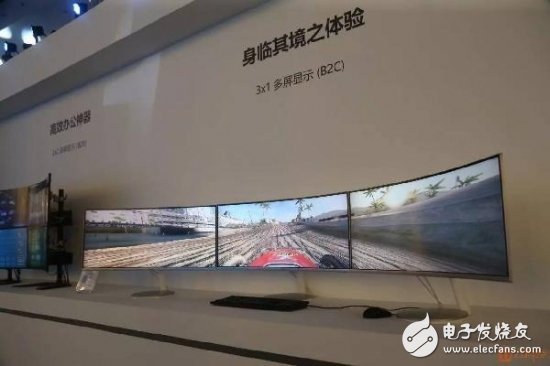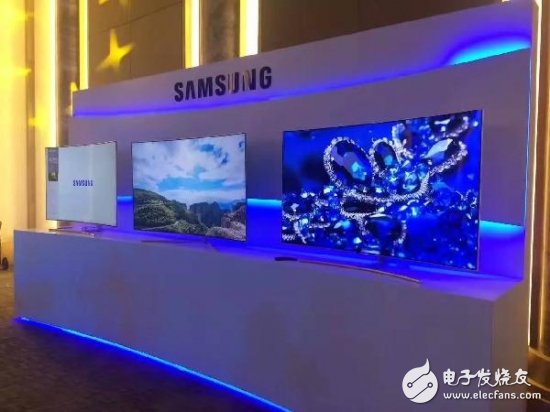"Is it better to bend or straight?" In the sales area of ​​home appliance stores, this may become an increasingly common question. "Bent" is either or, and "straight" is also a common flat-panel color TV. Perhaps at this stage, the answer is still inconsistent, but DingTalk is optimistic about the development prospects of curved display products. On the one hand, the color TV industry with flat panel products as the mainstream has fallen into a growth bottleneck as a whole; on the other hand, curved display products have maintained an average annual growth rate of over 300% since 2014. In this view, curved display products are expected to create new "disruptive" opportunities for the color TV industry and break through the industry ceiling.

The industry needs new kinetic energy. The lack of demand for color TVs is not a new topic in recent years. Looking at the recent market performance, this sluggishness is clearly continuing: According to the monitoring data of Zhongyikang, in the first half of 2017, China’s color TV market shipments were 22.51 million units, a year-on-year decrease of 10.8%; retail sales were 75.4 billion. Yuan, a slight increase of 0.8%, showing an overall trend of derating and increasing.
Even in the emerging online channels, the performance is not outstanding. According to the Analysis Report on Home Grid Purchase in the First Half of 2017, from January to June 2017, online retail sales of flat-screen TVs increased by only 10.1%, 88.2% for air conditioners, 36.7% for refrigerators, 43.5% for washing machines, 50.4% for kitchen appliances, and 54% for air-conditioning. % And 37.6% of water purification equipment are far from each other. In addition, comparing this data with the above-mentioned Zhongyikang data, it is not difficult to find the "tragic" offline color TV sales.
It is also in this context that manufacturers have chosen to seek breakthroughs in display technology, product design, performance enhancement, functional improvement and even external devices.

Nail Technology believes that the ceiling of the color TV industry, which is dominated by flat-panel TVs, is caused by the solidified product form of "flat-panel". The revival of the TV industry may be a feasible way to change the flat-panel form of TVs, in addition to the innovation and optimization of display technology, if it is only from the TV itself.
The reality shows that "turning the screen into a curve" may be one of the ways out. Since its listing in 2014, the curved display has maintained an average annual growth rate of more than 300%, successfully occupying a stable position in the high-end market. According to Zhongyikang's forecast, the sales of curved TVs in the Chinese market will exceed 4 million units in 2017. Based on the data in May of this year, the sales share of large sizes over 48 inches has reached 23%.
At the beginning of the year, when the overall market was not good, curved TVs grew against the trend and already demonstrated their strength as a new kinetic energy.
The obvious advantages of curved surface products can grow against the trend, in the final analysis, because of the advantages of the product itself.
Spanish architect Antonio Gaudi once said: "Straight lines belong to human beings, and curves belong to God." Because there is no straight line in nature itself, all personalized beauty comes from the natural shaping of curves. One of the characteristics of the curved surface display product is the natural beauty in the product design.
The appearance design of the curved screen satisfies consumers' pursuit of home environment design and personalization. Home improvement designer Leng Fuchuan once said: The application of curves avoids the dullness and over-direction of straight lines. Appropriate application of curved surfaces and curves in the interior space will double the agility of the space.

Another point is the good look and feel that a display product must have. According to Ding Technology, the advantages of curved display compared to flat display are obvious: firstly, it can make a limited space to obtain a larger display area; secondly, it is more in line with the structure of the human eye and conforms to the human body engineering. Every point on the screen reaches the eye. The distances are equal, making the human eye more comfortable in the viewing process. Third, you can enjoy a strong three-dimensional picture, which can bring an undoubtedly comparable sense of presence, and bring consumers an immersive viewing experience, which can meet the higher requirements of consumers beyond the basic vision.
In addition to the above two points, the design of curved TVs also conforms well to the trend of display technologies such as quantum dots, ULED, OLED, and large-screen TVs.
Consumption upgrades into trends As mentioned above, the color TV market as a whole shows a trend of derating and increasing. In addition, from the perspective of product trends, large-screen and high-end trends have become the main trends, which are consistent with the current background of a new round of consumption upgrades. In this view, consumption upgrades may be an excellent opportunity for color TV manufacturers to break through the ceiling. Curved products also have natural adaptability to consumption upgrades. Nail Technology believes that consumption upgrades must be achieved from the pursuit of cost-effectiveness to the pursuit of quality improvement, from focusing on functionality to improving the overall product experience, and from being practical and easy to use to improving aesthetics and taste.
There are three points in the adaptation of curved products to consumption upgrades:
First of all, curved products conform to the trend of high-end and large-screen color TVs. For curved products, this is almost inevitable, because large-size curved products can truly show the effect of surround and immersion. What can be learned is that mainstream curved products of various manufacturers, especially color TV products, are all in size 55 Inches and above.
Secondly, curved products have been combined with cutting-edge technologies from the very beginning. Compared with flat-panel TVs that have undergone a long period of continuous evolution, high resolutions such as 4K and 8K, auxiliary technologies such as HDR, and display technologies such as quantum dots, ULED, OLED, and laser displays have quickly been integrated and applied in curved products.
Thirdly, curved products meet individual consumption and needs, and provide users with added value. Under the trend of consumption upgrading, for home appliances, consumers are not only concerned about their practicability, but the design of curved screens also satisfies consumers' pursuit of home environment design and personalization.
The giants work together to promote development. Experience the "controversy of straightness" and "controversy of thinness". Curved TVs have not been declining because of such sayings as "manpower bending". Instead, they have shown more vitality in the market than before. Only the continuous maturity of technology can break the shackles and doubts. This process is naturally driven by the joint efforts of the giants for many years. This is the TV manufacturers such as Samsung, TCL, Hisense, Konka, Changhong, Haier, Xiaomi, LeTV, and monitors such as TPV and Huike. The joint efforts of manufacturers.
In 2013, Samsung took the lead in launching curved TVs in China, which opened the curtain of the era of curved surfaces. In 2014, both Samsung and LG demonstrated 4K TVs with flexible screen designs at CES. Users only need to press a button to switch between curved and flat states. In 2015, Samsung expanded its size to 105 inches, an ultra-wide ratio, and the switching speed of curved surfaces/flat surfaces was smoother. At CES2016, Samsung launched a subversive ultra-thin curved TV, breaking the situation where thinness and curvature cannot have both. Ultra-thin curved TVs have become a trend pursued by the TV industry.
In 2015, Hisense's 85-inch curved laser TV came out, which was well received by everyone. In 2016, Hisense will still pay attention to the promotion and layout of curved products, from the smallest 40 inches to the highest 85 inches, with assistance in quantum technology, etc., with curved surfaces as a key development direction.
TCL promises to give consumers the best curved products and the strongest lineup risk. In 2016, CES released high-end QUHD quantum products and flagship product X1. Through the integration of quantum display materials, quantum image quality processing engine, and multi-dimensional comprehensive image quality improvement technology, it brought the world's first-class curved TV products and in-depth experience . TCL has said that the launch of Quantum TV not only represents the advent of another top technology product in the color TV industry, but also represents the birth of the highest-end products of TCL curved TVs. It is a major move by TCL in the layout of curved TVs.

At the second curved display forum this year, Samsung’s 65-inch Glass LGP, which was first disclosed by Samsung, adopted an integrated module structure to achieve the thinnest ultra-thin design with a thickness of only 4.9mm. The simple design can be perfectly integrated with the original furniture decoration. This 65-inch curved TV named "S-Curved" displays a curved concave lens form on the left and right sides of the TV. Based on the past special pixels for curved surfaces, combined with the upper and lower curvature design, it can be perfectly embedded in walls, buildings or flat products. Use is a brand-new concept display that provides the possibility for the emergence of new forms of television.
Zhang Shaoyong, general manager of TCL Multimedia Product Center, said, “At the beginning of this year, we brought three new curved surface series. Curved surfaces have become the cornerstone of TCL's differentiated appearance product design.†Last year, TCL’s curved TVs sold in the domestic TV market. More than 700,000 units, "This means that consumers' awareness and acceptance of curved TVs has been greatly improved; the beauty of curved surfaces and the wonder (wonderful) of viewing experience have been recognized by consumers."
Data from Zhongyikang shows that in the past year, the number of brands and products using curved displays in China has increased rapidly. As of May of this year, a total of 33 brands have adopted curved display products and launched 289 models, nearly twice the number of last year.
Fitting with new technologies, adapting to new consumer needs, and the joint promotion of manufacturers, all make curved TVs show strong vitality. Nail Technology believes that in China, curved surfaces may be another outlet for the TV industry following the Internet, large screens and intelligence. "The curve belongs to God", and curved TV should belong to more "God"-consumers.
Liquid Crystal Display,Lcd Screen Displays,Calculator Lcd Display,Lcd Display For Car Bluetooth
Dongguan Yijia Optoelectronics Co., Ltd. , https://www.everbestlcdlcm.com